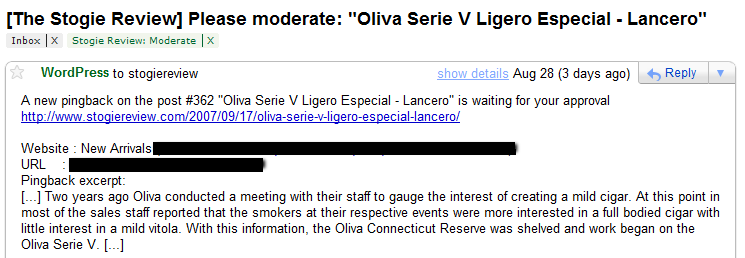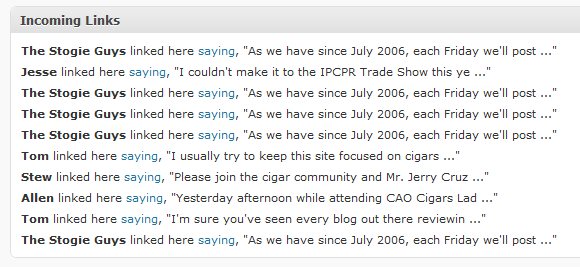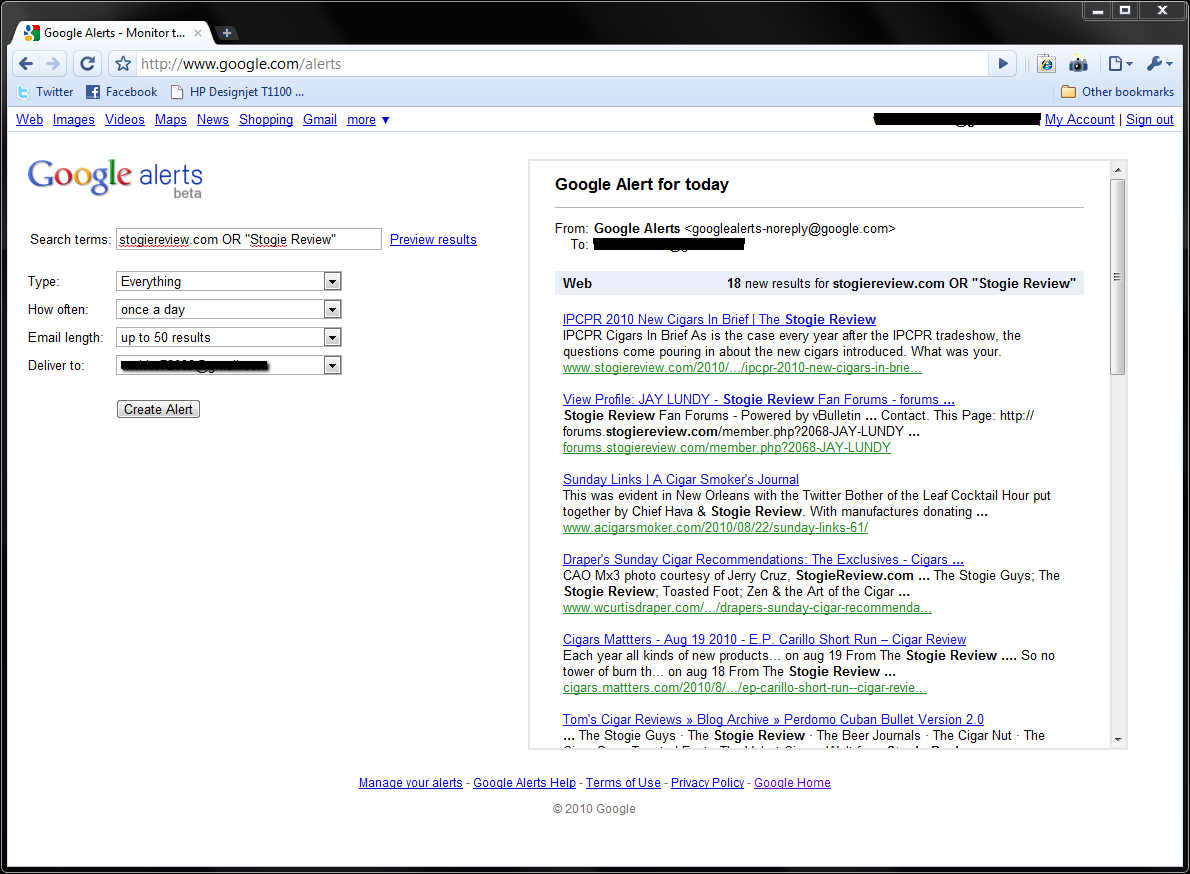Having been a cigar blogger for more than four-years , it is not uncommon for Stogie Review
, it is not uncommon for Stogie Review to receive questions on how to handle reviews and articles being republished, without permission. Under most circumstances this type of problem is the direct result of a scraper site.
to receive questions on how to handle reviews and articles being republished, without permission. Under most circumstances this type of problem is the direct result of a scraper site.
To make our blogs convenient, we package our work into neat and tidy RSS Feeds and allow people to subscribe. Through our RSS Feeds, readers have our creative works delivered directly to their virtual doorstep.
and allow people to subscribe. Through our RSS Feeds, readers have our creative works delivered directly to their virtual doorstep.
A scraper site takes that neat and tidy RSS Feed and uses a plugin to regurgitate the content. Often times your content will be speckled with links and advertisements to generate revenue. Setting up a site such as this is quick and easy, with very little upkeep, allowing the owner to move on and setup dozens of others.
The objective of this article is to give you a little advice on how to spot your stolen content. The system I use is painfully simple and only requires action when I suspect that my work has been republished. Please note that I am a self-hosted WordPress user and some parts of this article may not work for you on another service.
I’ve Been Scraped:
The first time I came across my content on a scraper site it resulted in mixed emotions. Initially I was excited at the thought of my work being good enough to warrant stealing. It didn’t take long for the giddiness to wear off, leaving me feeling violated. As I stared at my stolen creative work, rage boiled up inside me when I realized that it was spattered with ads. Not only was this individual stealing something that I worked long and hard on, they were making money off of it.
Like most people I just thought to myself “It’s the Internet, theres nothing I can do about it”. When other sites were brought to my attention, I ignored them thinking that doing anything was a hopeless task. I kept telling myself that my content would pop up first through a google search and that these scraper sites wouldn’t get many eyes on them.
I don’t know what finally caused me to stop ignoring them and take action, but I sat down and started researching my options. The first thing I wanted to do was make sure that I was aware of these sites when they popped up.
Comments In Moderation:
One thing that every blogger should do is link to their past work. Not only does it give your readers the opportunity to travel deeper into your site, it also gives you a heads up when another blog links to your content.
The benefit to this, when on WordPress, is that if you have comment moderation on, you will have comments brought to your attention before they appear on your blog. I like to use this to my advantage and screen pingbacks for suspicious text. If something just doesn’t look right, I’ll click through and see what has been said about my particular article. In the event that a scraper site has stolen and republished your work, they will have just notified you.

The text seemed familiar to me, in this case, because it was a portion of one of my past reviews.
Incoming Links:
In the event that the scraper site stealing your content has pingbacks disabled, you can still monitor incoming links to your blog. From what I’ve seen most often, these sites simply republish your content without stripping relevant links (which is yet another reason to link to your past work).
Taking this into consideration, we can monitor incoming links right from the WordPress dashboard. In the “Screen Options”, you have the ability to view incoming links. The pane operates on a Google Blog Search fed through an RSS feed.
The URL can be customized to your liking, but I prefer to leave it as-is. I find that the Incoming Links pane can be hit or miss and doesn’t catch everything. I’ve seen it miss links from major blogs within the niche one day and pick up brand new scraper sites the next. Regardless of how well it works, it doesn’t hurt to keep an eye on it since it resides inside the WordPress dashboard.

Google Alerts:
My favorite tool for monitoring Stogie Review content, as well as the brand, is Google Alerts . If you aren’t familiar with this tool from Google, it is a super simple way or passively monitoring keywords. All you need to do is plug in a couple of keywords (in my case stogiereview OR “Stogie Review” as well as waltinpa OR “Walt In PA”), tell Google how often you would like to receive alerts, and set the method of delivery.
. If you aren’t familiar with this tool from Google, it is a super simple way or passively monitoring keywords. All you need to do is plug in a couple of keywords (in my case stogiereview OR “Stogie Review” as well as waltinpa OR “Walt In PA”), tell Google how often you would like to receive alerts, and set the method of delivery.
In my case, I receive an email each week with a digest of the latest mentions of my keywords from across the web. Within a couple of weeks you will learn who mentions your brand regularly. This allows you to skim part of the list while investigating others.

Filing a DMCA Notice:
In the event that you use Comment Moderation, Incoming Links, and Google Alerts to track down a scraper site hosting your content, your next move is to take action. I’ve read a number of articles which say that you should be diplomatic and contact the site owner about the problem. It could potentially be a simple misunderstanding and easily resolved with one email.
I must confess, nine times out of ten I go straight to filing a DMCA takedown notice with the host. This is a formal notice to the host informing them that content with my copyright appears on their web server. Generally, when I find my work republished it appears to have been automated and contact information is missing.
On occasion I am alerted to a retailer or manufacturer using my work as a sales tool. Most often this is a simple copy/paste of a product review used as a testimonial with no credit given to its original author. In these cases I also bypass the friendly email and go straight to the DMCA notice.
For more on filing a DMCA Takedown Notice, read over How to Defend your Blogs Copyright from Problogger . The article is very informative and contains the templates that I use to file notices.
. The article is very informative and contains the templates that I use to file notices.
Keep On top of It:
Some months are better than others. I may not file a single DMCA notice one month while sending out ten the month before. It can be mentally exhausting to protect your creative works, but it is the only way you can be sure that your work doesn’t wind up anywhere without your permission.
The goal of this article isn’t to send you running off across the internet, roaring a battle cry. Finding a portion of your creative work on another blog with credit and a link attributed to you is no reason to file a DMCA notice. If anything, it should result in a quick thank-you email.
Through the use of Comments Moderation Emails, Incoming Links, and Google Alerts, keeping an eye on your content becomes less work and easier to manage. I hope you found this article useful. If you have any tips, please use the comment section to share.
One thought on “Monitoring Your Creative Works”
Comments are closed.
Recent Posts
When most people think about Motorcycle Group Rides, I believe it conjures up images of large packs of Harley Davidson Motorcycles riding for a cause. While there is no shortage of these types of...
On June 18, 2023, I went for a Father's Day Motorcycle Ride to Lancaster, PA, to see a historic covered bridge. I was stopped at a traffic light at the intersection of PA Rt 422 East and PA Rt 82...

Good advice Walt. I really should understand how RSS and readers work.